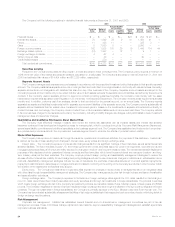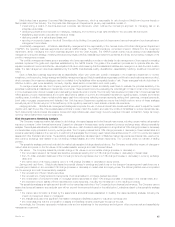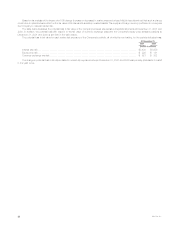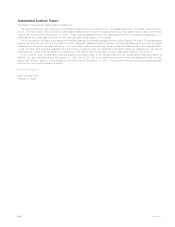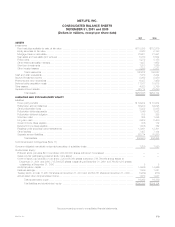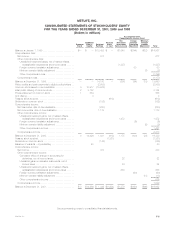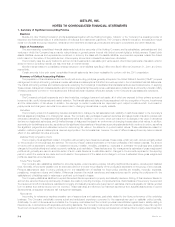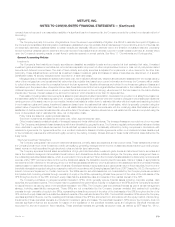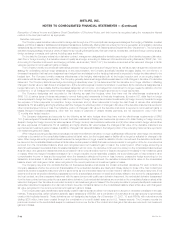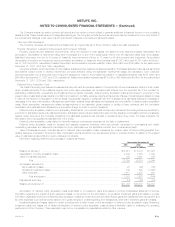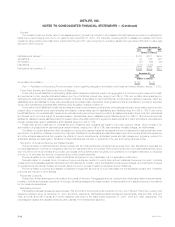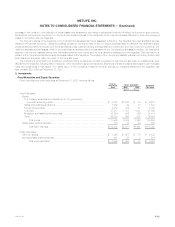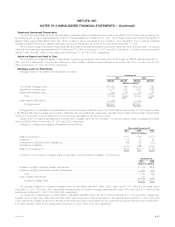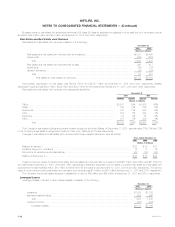MetLife 2001 Annual Report Download - page 47
Download and view the complete annual report
Please find page 47 of the 2001 MetLife annual report below. You can navigate through the pages in the report by either clicking on the pages listed below, or by using the keyword search tool below to find specific information within the annual report.METLIFE, INC.
NOTES TO CONSOLIDATED FINANCIAL STATEMENTS
1. Summary of Significant Accounting Policies
Business
MetLife, Inc. (the ‘‘Holding Company’’) and its subsidiaries (together with the Holding Company, ‘‘MetLife’’ or the ‘‘Company’’) is a leading provider of
insurance and financial services to a broad section of individual and institutional customers. The Company offers life insurance, annuities and mutual
funds to individuals and group insurance, reinsurance and retirement and savings products and services to corporations and other institutions.
Basis of Presentation
The accompanying consolidated financial statements include the accounts of the Holding Company and its subsidiaries, partnerships and joint
ventures in which the Company has a majority voting interest or general partner interest with limited removal rights by limited partners. Closed block
assets, liabilities, revenues and expenses are combined on a line by line basis with the assets, liabilities, revenues and expenses outside the closed
block based on the nature of the particular item. Intercompany accounts and transactions have been eliminated.
The Company uses the equity method to account for its investments in real estate joint ventures and other limited partnership interests in which it
does not have a controlling interest, but has more than a minimal interest.
Minority interest related to consolidated entities included in other liabilities was $442 million and $409 million at December 31, 2001 and 2000,
respectively.
Certain amounts in the prior years’ consolidated financial statements have been reclassified to conform with the 2001 presentation.
Summary of Critical Accounting Policies
The preparation of financial statements in conformity with accounting principles generally accepted in the United States of America (‘‘GAAP’’) requires
management to adopt accounting policies and make estimates and assumptions that affect amounts reported in the consolidated financial statements.
The critical accounting policies and related judgments underlying the Company’s consolidated financial statements are summarized below. In applying
these policies, management makes subjective and complex judgments that frequently require estimates about matters that are inherently uncertain. Many
of these policies are common in the insurance and financial services industries; others are specific to the Company’s businesses and operations.
Investments
The Company’s principal investments are in fixed maturities, mortgage loans and real estate, all of which are exposed to three primary sources of
investment risk: credit, interest rate and market valuation. The financial statement risks are those associated with the recognition of income, impairments
and the determination of fair values. In addition, the earnings on certain investments are dependent upon market conditions which could result in
prepayments and changes in amounts to be earned due to changing interest rates or equity markets.
Derivatives
The Company enters into freestanding derivative transactions to manage the risk associated with variability in cash flows related to the Company’s
financial assets and liabilities or to changing fair values. The Company also purchases investment securities and issues certain insurance policies with
embedded derivatives. The associated financial statement risk is the volatility in net income, which can result from (i) changes in fair value of derivatives
that are not designated as hedges, and (ii) ineffectiveness of designated hedges in an environment of changing interest rates or fair values. In addition,
accounting for derivatives is complex, as evidenced by significant interpretations of the primary accounting standards which continue to evolve, as well as
the significant judgments and estimates involved in determining fair value in the absence of quoted market values. These estimates are based on
valuation methodologies and assumptions deemed appropriate in the circumstances; however, the use of different assumptions may have a material
effect on the estimated fair value amounts.
Deferred Policy Acquisition Costs
The Company incurs significant costs in connection with acquiring new insurance business. These costs, which vary with, and are primarily related
to, the production of new business, are deferred. The recovery of such costs is dependent on the future profitability of the related business. The amount
of future profit is dependent principally on investment returns, mortality, morbidity, persistency, expenses to administer the business (and additional
charges to the policyholders) and certain economic variables, such as inflation. These factors enter into management’s estimates of gross margins and
profits which generally are used to amortize certain of such costs. Revisions to estimates result in changes to the amounts expensed in the reporting
period in which the revisions are made and could result in the impairment of the asset and a charge to income if estimated future gross margins and
profits are less than amounts deferred.
Future Policy Benefits
The Company also establishes liabilities for amounts payable under insurance policies, including traditional life insurance, annuities and disabled
lives. Generally, amounts are payable over an extended period of time and the profitability of the products is dependent on the pricing of the products.
Principal assumptions used in pricing policies and in the establishment of liabilities for future policy benefits are mortality, morbidity, expenses,
persistency, investment returns and inflation. Differences between the actual experience and assumptions used in pricing the policies and in the
establishment of liabilities result in variances in profit and could result in losses.
The Company establishes liabilities for unpaid claims and claims expenses for property and casualty insurance. Pricing of this insurance takes into
account the expected frequency and severity of losses, the costs of providing coverage, competitive factors, characteristics of the property covered and
the insured, and profit considerations. Liabilities for property and casualty insurance are dependent on estimates of amounts payable for claims reported
but not settled and claims incurred but not reported. These estimates are influenced by historical experience and actuarial assumptions of current
developments, anticipated trends and risk management strategies.
Reinsurance
Accounting for reinsurance requires extensive use of assumptions and estimates, particularly related to the future performance of the underlying
business. The Company periodically reviews actual and anticipated experience compared to the assumptions used to establish policy benefits.
Additionally, for each of its reinsurance contracts, the Company must determine if the contract provides indemnification against loss or liability relating to
insurance risk, in accordance with applicable accounting standards. The Company must review all contractual features, particularly those that may limit
the amount of insurance risk to which the Company is subject or features that delay the timely reimbursement of claims. If the Company determines that a
MetLife, Inc.
F-8


